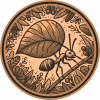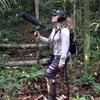With new technologies revolutionizing data collection, wildlife researchers are becoming increasingly able to collect data at much higher volumes than ever before. Now we are facing the challenges of putting this information to use, bringing the science of big data into the conservation arena. With the help of machine learning tools, this area holds immense potential for conservation practices. The applications range from online trafficking alerts to species-specific early warning systems to efficient movement and biodiversity monitoring and beyond.
However, the process of building effective machine learning tools depends upon large amounts of standardized training data, and conservationists currently lack an established system for standardization. How to best develop such a system and incentivize data sharing are questions at the forefront of this work. There are currently multiple AI-based conservation initiatives, including Wildlife Insights and WildBook, that are pioneering applications on this front.
This group is the perfect place to ask all your AI-related questions, no matter your skill level or previous familiarity! You'll find resources, meet other members with similar questions and experts who can answer them, and engage in exciting collaborative opportunities together.
Just getting started with AI in conservation? Check out our introduction tutorial, How Do I Train My First Machine Learning Model? with Daniel Situnayake, and our Virtual Meetup on Big Data. If you're coming from the more technical side of AI/ML, Sara Beery runs an AI for Conservation slack channel that might be of interest. Message her for an invite.
Header Image: Dr Claire Burke / @CBurkeSci

Explore the Basics: AI
Understanding the possibilities for incorporating new technology into your work can feel overwhelming. With so many tools available, so many resources to keep up with, and so many innovative projects happening around the world and in our community, it's easy to lose sight of how and why these new technologies matter, and how they can be practically applied to your projects.
Machine learning has huge potential in conservation tech, and its applications are growing every day! But the tradeoff of that potential is a big learning curve - or so it seems to those starting out with this powerful tool!
To help you explore the potential of AI (and prepare for some of our upcoming AI-themed events!), we've compiled simple, key resources, conversations, and videos to highlight the possibilities:
Three Resources for Beginners:
- Everything I know about Machine Learning and Camera Traps, Dan Morris | Resource library, camera traps, machine learning
- Using Computer Vision to Protect Endangered Species, Kasim Rafiq | Machine learning, data analysis, big cats
- Resource: WildID | WildID
Three Forum Threads for Beginners:
- I made an open-source tool to help you sort camera trap images | Petar Gyurov, Camera Traps
- Batch / Automated Cloud Processing | Chris Nicolas, Acoustic Monitoring
- Looking for help with camera trapping for Jaguars: Software for species ID and database building | Carmina Gutierrez, AI for Conservation
Three Tutorials for Beginners:
- How do I get started using machine learning for my camera traps? | Sara Beery, Tech Tutors
- How do I train my first machine learning model? | Daniel Situnayake, Tech Tutors
- Big Data in Conservation | Dave Thau, Dan Morris, Sarah Davidson, Virtual Meetups
Want to know more about AI, or have your specific machine learning questions answered by experts in the WILDLABS community? Make sure you join the conversation in our AI for Conservation group!
No showcases have been added to this group yet.
- @ryanhuang
- | He/Him/His
Conservation scientist based in Pretoria, South Africa
- 0 Resources
- 0 Discussions
- 6 Groups
- @jsstamn
- | She/her
PhD student at the University of Mississippi; research interests include predator/prey dynamics, particularly the landscape of fear in relation to species conservation. Rookie at using arduino
- 0 Resources
- 4 Discussions
- 5 Groups
Neuroscientist & engineer looking for a data/R&D role in conservation.
- 0 Resources
- 0 Discussions
- 17 Groups
I am a research scientist from the AI for Good Lab at Microsoft, working on AI applications in environmental science and ecology, including camera traps, bioacoustics, and overhead imagery.


- 1 Resources
- 7 Discussions
- 1 Groups
An Environmental sciences and Management graduate from SUA, passionate and eager to drive change to the Environment, making World a better place for present and future generations.





- 4 Resources
- 35 Discussions
- 14 Groups
- @hyodopenguin
- | she/her
I am currently a rising junior at UC Berkeley studying data science. I hope to apply data with biodiversity, especially by utilizing camera traps for species classification. People in conservation tech are truly living my dream careers, and I can't wait to get even more inspired!

- 0 Resources
- 5 Discussions
- 23 Groups
- @AngelikaNocon
- | she/her
I am a Nonprofit Relations Manager at Tech To The Rescue - a global platform connecting nonprofit organizations with tech companies.
- 0 Resources
- 3 Discussions
- 4 Groups
- @Slater
- | he/him
I am the Conservation Science Director at HawkWatch International, where I've worked since 2006. My work focuses mainly on conservation and research of Golden Eagles, including nesting, tracking, and winter ecology.

- 0 Resources
- 2 Discussions
- 4 Groups
Mobile developer w/ a passion for nature and conservation

- 1 Resources
- 17 Discussions
- 6 Groups
I'm a researcher in aquatic sciences, studying connections between fish biology and endocrine systems that govern growth and reproduction, contributing to fisheries management, conservation efforts and aquaculture innovations.
- 0 Resources
- 0 Discussions
- 5 Groups
- @christinebarry
- | she/her
- 0 Resources
- 0 Discussions
- 2 Groups
- 0 Resources
- 1 Discussions
- 4 Groups
To celebrate our newly-lauched WILDLABS Fellowship: On the Edge, I spoke with the Edge Impulse team about why uniting the conservation and tech worlds to make funding, tools, training, and support accessible and...
9 August 2021
Article
Wildlife Insights is excited to announce the public release of their new platform! Read on to learn about all the useful features you'll find on Wildlife Insights, and check out WILDLABS' Tech Tutors episode with...
27 July 2021
Article
Apply now for the WILDLABS Fellowship: On the Edge! With a $6,500 award, expert AI mentorship from Edge Impulse, and access to the world’s biggest conservation technology community, this fellowship can help you create...
21 July 2021
The following terms and conditions (the “Terms & Conditions”) shall apply to the WILDLABS Fellowship: On the Edge for the year 2021-2022 (the “Fellowship”) being awarded by Fauna & Flora International (“FFI”) (...
19 July 2021
Article
Read on for our FAQs on the new WILDLABS Fellowship: On the Edge, including information on applying to this opportunity.
19 July 2021
Our friends at BearID joined an EXPLORE.org live chat to discuss their work identifying the bears of Katmai National Park with powerful AI technology. Watch the full panel event below, or here on EXPLORE.org's Youtube...
1 July 2021
A new issue of Methods in Ecology and Evolution from the British Ecological Society is now available for download. In this issue, WILDLABS readers will enjoy research involving conservation dogs and non-invasive...
23 April 2021
ZSL's Remote Sensing in Ecology and Conservation journal has released new research for early view before inclusion in an issue. See the full list of recent open access research papers on RSEC.
22 April 2021
Community Announcement
Whether you spent the last year working in the field, lab, at home, or virtually, the WILDLABS community's conservation tech achievements were on full display in our annual #Tech4Wildlife Photo Challenge! Relive our...
25 March 2021
Article
In this article from Whale Seeker, you'll read about how human expertise plays a role in building strong AI algorithms and achieving accurate wildlife identification results, as well as the ethics of using AI in these...
15 March 2021
This year's iWildCam competition is now live on kaggle. Go beyond just classifying species or detecting animals - this year the challenge focuses on counting how many individuals of each species are seen in a burst of...
12 March 2021
National Geographic is offering funding up to up to $50,000 for conservationists conducting research on how the pandemic has impacted wildlife and conservation work. If you are interested in researching aspects of the...
10 March 2021
August 2025
event
September 2025
event
event
event
event
October 2025
event
event
event
December 2025
event
March 2026
January 2023
December 2022
17 Products
Recently updated products
| Description | Activity | Replies | Groups | Updated |
|---|---|---|---|---|
| Hi Simon,We (Reneco International Wildlife Consultants) have an ongoing collaboration with a local University (Abu Dhabi, UAE) for developing AI tools (cameratrap/drone... |
|
Acoustics, AI for Conservation, Animal Movement, Camera Traps, Citizen Science, Connectivity, Drones, Early Career, eDNA & Genomics, Marine Conservation, Protected Area Management Tools, Sensors | 7 months ago | |
| @HeinrichS there’s still time for you or anyone else to make a funding submission to the wildlabs 2025 grants ❤️❤️❤️I haven't applied for wildlabs funding, but I would love for... |
|
Human-Wildlife Coexistence, AI for Conservation, Camera Traps, Emerging Tech | 7 months ago | |
| thanks kristy! super helpful list. |
|
Data management and processing tools, AI for Conservation | 7 months 1 week ago | |
| And I see now they can walk vertically up walls like Spider-Man. |
|
Camera Traps, AI for Conservation | 7 months 1 week ago | |
| Thank you for the comments. My team will be glad to have this added to the inventory. |
|
AI for Conservation | 7 months 1 week ago | |
| I added plain old motion detection because megadetector v5 was not working well with the smaller rat images and in thermal.This works really well: Also, I can see... |
|
AI for Conservation, Camera Traps | 7 months 2 weeks ago | |
| Hello WalterThanks for your input. I have achieved better results with the puc when hooking it up to a powerbank. Have got them set up to "recording only", and GPS to low power... |
|
Acoustics, AI for Conservation, Citizen Science, Sensors | 7 months 4 weeks ago | |
| great, this security cameras might be interesting for monitoring crop development and maybe other bigger pests like boars or some other herbivorous animals that could eventually... |
|
AI for Conservation, Camera Traps | 8 months ago | |
| In a recent call with researchers in Thailand. They have mentioned that they use passive chip readers to log data about chipped animals as they pass by. |
+12
|
AI for Conservation, Animal Movement | 8 months ago | |
| Seems like we should include some rotations in our image augmentations as the real world can be seen a bit tilted - as this cropped corner view from our fisheye at the zoo shows. |
+13
|
AI for Conservation, Camera Traps, Data management and processing tools | 8 months 1 week ago | |
| Bird Monitoring Data Exchange is a standard often used for birds data. |
+4
|
AI for Conservation, Data management and processing tools, Emerging Tech | 8 months 2 weeks ago | |
| Hey everyone!As you might have heard, BlueSky is on hype now, with millions of users migrating to it from X. Including the scientific world... |
|
AI for Conservation | 8 months 3 weeks ago |















































